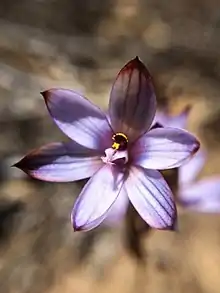| Flushed sun orchid | |
|---|---|
 | |
| Thelymitra canaliculata near Ongerup | |
| Scientific classification | |
| Kingdom: | Plantae |
| Clade: | Tracheophytes |
| Clade: | Angiosperms |
| Clade: | Monocots |
| Order: | Asparagales |
| Family: | Orchidaceae |
| Subfamily: | Orchidoideae |
| Tribe: | Diurideae |
| Genus: | Thelymitra |
| Species: | T. canaliculata |
| Binomial name | |
| Thelymitra canaliculata | |
| Synonyms[1] | |
|
Thelymitra campanulata Endl. | |
Thelymitra canaliculata, commonly called the flushed sun orchid[2] or blue sun orchid[3] is a species of orchid in the family Orchidaceae and is endemic to the south-west of Western Australia. It has a single erect, fleshy leaf and up to twenty eight blue flowers with darker veins and sometimes flushed with pink. The lobe on top of the anther is blackish with a yellow crest.
Description
Thelymitra canaliculata is a tuberous, perennial herb with a single erect, fleshy, channelled, linear to lance-shaped leaf 200–350 mm (8–10 in) long and 1–6 mm (0.04–0.2 in) wide. Between three and twenty eight pale to dark blue flowers with darker veins and sometimes flushed with pink, 15–36 mm (0.6–1 in) wide are borne on a flowering stem 200–850 mm (8–30 in) tall. The sepals and petals are 8–18 mm (0.3–0.7 in) long and 3–9 mm (0.1–0.4 in) wide. The column is pale blue near its base then blackish, 4–6 mm (0.16–0.24 in) long and 2.5–4 mm (0.1–0.2 in) wide. The lobe on the top of the anther is blackish with a yellow, toothed tip. The side lobes have mop-like tufts of white hairs. The flowers are insect pollinated and open on sunny days.Flowering occurs from October to December.[2][3][4][5]
Taxonomy and naming
Thelymitra canaliculata was first formally described in 1810 by Robert Brown and the description was published in Prodromus Florae Novae Hollandiae et Insulae Van Diemen.[6][7] The specific epithet (canaliculatum) is a Latin word meaning "channelled' or "grooved".[8]
Distribution and habitat
The flushed sun orchid grows in isolated populations on the margins of swamps between Augusta and Albany in the Jarrah Forest and Warren biogeographic regions.[2][3][9]
Conservation
Thelymitra canaliculata is classified as "not threatened" by the Western Australian Government Department of Parks and Wildlife.[9]
References
- 1 2 "Thelymitra canaliculata". World Checklist of Selected Plant Families (WCSP). Royal Botanic Gardens, Kew.
- 1 2 3 Jones, David L. (2006). A complete guide to native orchids of Australia including the island territories. Frenchs Forest, N.S.W.: New Holland. p. 244. ISBN 1877069124.
- 1 2 3 Brown, Andrew; Dundas, Pat; Dixon, Kingsley; Hopper, Stephen (2008). Orchids of Western Australia. Crawley, Western Australia: University of Western Australia Press. p. 430. ISBN 9780980296457.
- ↑ Hoffman, Noel; Brown, Andrew (2011). Orchids of South-West Australia (3rd ed.). Gooseberry Hill: Noel Hoffman. p. 309. ISBN 9780646562322.
- ↑ Jeanes, Jeffrey (2001). "Resolution of the Thelymitra canaliculata R.Br. (Orchidaceae) complex in southern Australia" (PDF). Muelleria. 15: 76–79. Retrieved 28 May 2018.
- ↑ "Thelymitra canaliculata". APNI. Retrieved 28 May 2018.
- ↑ Brown, Robert (1810). Prodromus florae Novae Hollandiae. London. p. 314. Retrieved 14 May 2018.
- ↑ Brown, Roland Wilbur (1956). The Composition of Scientific Words. Washington, D.C.: Smithsonian Institution Press. p. 274.
- 1 2 "Thelymitra canaliculata". FloraBase. Western Australian Government Department of Biodiversity, Conservation and Attractions.
External links
 Media related to Thelymitra canaliculata at Wikimedia Commons
Media related to Thelymitra canaliculata at Wikimedia Commons